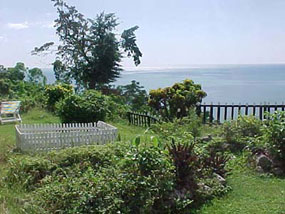Chebuctoo Great House
Parish: Westmoreland
Chebuctoo is situated near the small village of Cave on a pimento plantation. The Great House derives its North American Indian name from the former name of Halifax in Nova Scotia with which Jamaica had considerable trade in the 18th century, especially in salted fish. The Great House possesses characteristic Georgian features: decorated with cutstone quoins and keystones over some of the window apertures, the house is two storied with a gabled shingled roof. Two small porches placed one above the other face the sea, supported by three slender wooden posts on the upper storey, but were replaced on the lower floor by concrete pillars when the building was damaged by the earthquake of 1957.
 Indeed the very construction of the house began with disaster: in 1780 there was a terrible hurricane which devastated Jamaica, and eight families decided to build houses which were hurricane-proof. An architect from England was hired for that specific purpose and Chebuctoo was one of the new homes.
Indeed the very construction of the house began with disaster: in 1780 there was a terrible hurricane which devastated Jamaica, and eight families decided to build houses which were hurricane-proof. An architect from England was hired for that specific purpose and Chebuctoo was one of the new homes.
According to information found in the Jamaica Almanacs, Chebuctoo was owned by Frances Jones in 1811 who retained the property well into the 1830s. Prior to Frances however, Chebuctoo was said to have been owned by one Franny Jones who was reputed to have been a stern and cruel mistress in her dealings with the enslaved Africans. During her ownership, it was said that floggings and other severe punishments were the order of the day on the estate. She is buried in a vault at some little distance from the Great House.
Chebuctoo Great House was declared a national monument by the Jamaica National Heritage Trust on December 25, 2008.
SHOWCASE
|
SHOWCASE
|
SHOWCASE
|


